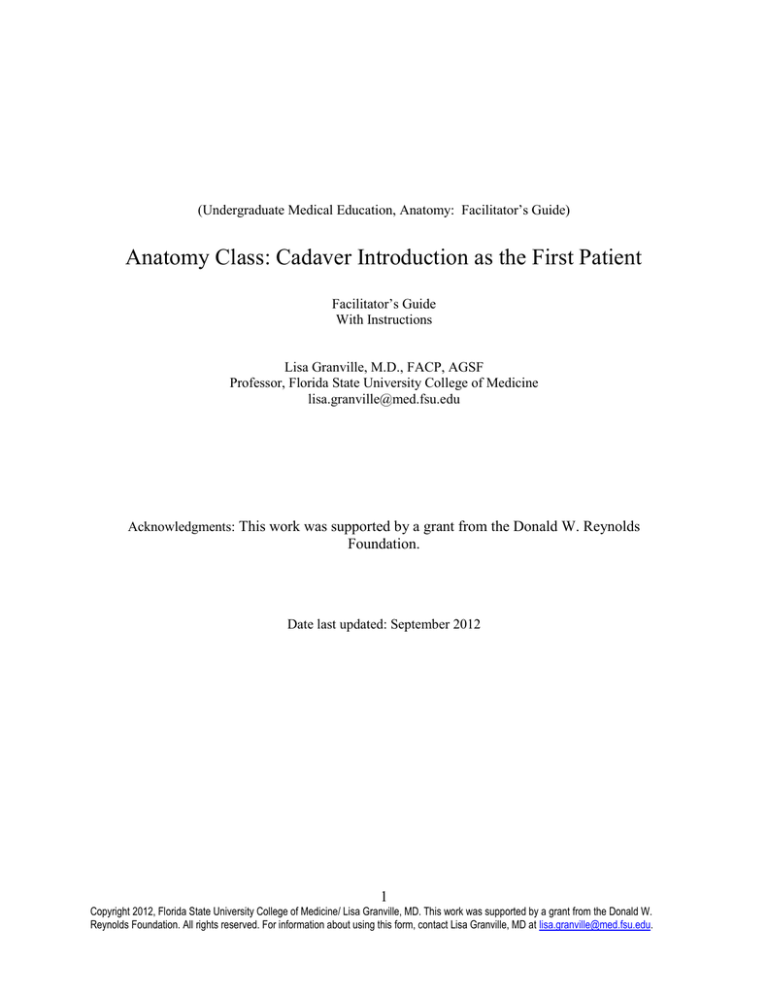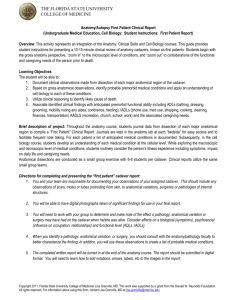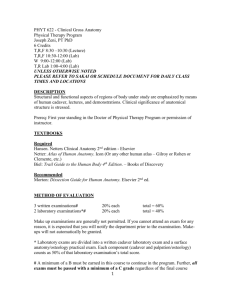
(Undergraduate Medical Education, Anatomy: Facilitator’s Guide)
Anatomy Class: Cadaver Introduction as the First Patient
Facilitator’s Guide
With Instructions
Lisa Granville, M.D., FACP, AGSF
Professor, Florida State University College of Medicine
lisa.granville@med.fsu.edu
Acknowledgments: This work was supported by a grant from the Donald W. Reynolds
Foundation.
Date last updated: September 2012
1
Copyright 2012, Florida State University College of Medicine/ Lisa Granville, MD. This work was supported by a grant from the Donald W.
Reynolds Foundation. All rights reserved. For information about using this form, contact Lisa Granville, MD at lisa.granville@med.fsu.edu.
Resource Description and Background:
The 2007 Institute of Medicine report advocated that healthcare professionals integrate geriatric content
into medical training to prepare for the rapidly increasing geriatrics population and its impact on all
aspects of health care. In addition, physicians and educators are encouraged to integrate basic science and
clinical content into medical education. Through the introduction of the “first patient,” these goals are met
by identifying and building upon the connections between human anatomy and physical diagnosis skills
and incorporating the age of the cadaver as a geriatric learning opportunity. (The average cadaver age is
73 years old and 80 percent are between the ages of 70 and 80 years old.)
We designed this 15-20 minute small-group, interactive exercise to integrate patient-centered clinical
skills with the anatomy class’ unveiling of the cadaver. This is a one-time involvement of clinical faculty
at the start of the anatomy course.
We introduce students to their first patient, the cadaver, and use this exercise to teach students how to
investigate the patient’s clinical history. Students thoroughly inspect the patient’s surface anatomy and
discuss the relevance of physical findings as attributable to normal aging or common age-associated
conditions. Students also discuss their ideas on the clinical implications of findings on the patient’s daily
life: symptoms, functional impact (i.e., ADLs, IADLs, and AADLs) and possible means of compensation.
Specific Learning Objectives:
By the end of this interactive exercise, the student will be able to:
1. Apply clinical observation skills of general appearance which include age, gender, body habitus,
and identifying features.
2. Identify physical findings in the geriatric population that are attributable to both normal aging and
common age-associated conditions.
3. Associate identified physical findings with anticipated impact on daily life, which include,
symptoms, functional impact (ADLs [bathing, dressing, grooming, mobility noting any aides,
continence, feeding], IADLs [phone use, medicine use, shopping, cooking, cleaning, finances,
transportation], and AADLs [recreation, church, school, work]), and possible means of
compensation.
Intended Audience:
This interactive exercise is intended for medical students and students from other healthcare disciplines
who learn anatomy with the assistance of a cadaver.
Prerequisites: None
Instructor Qualifications and Responsibilities:
Clinical faculty with experience teaching skills of physical diagnosis (medical history and physical
examination) lead the exercise as facilitators.
Alternative: Students that have successfully completed an introductory physical diagnosis course can
facilitate the exercise with clinical faculty supervision.
Required Resources
Teaching venue and suggested set-up: We suggest using the gross anatomy lab with cadavers placed
supine on dissection tables evenly spaced throughout the room to give small groups of 5-10 students
hands-on access to the cadaver from all directions. Providing metric rulers for measuring physical
findings and an information key with demographic details (identification number, age, occupation) about
each cadaver may enhance the clinical experience.
2
Copyright 2012, Florida State University College of Medicine/ Lisa Granville, MD. This work was supported by a grant from the Donald W.
Reynolds Foundation. All rights reserved. For information about using this form, contact Lisa Granville, MD at lisa.granville@med.fsu.edu.
Procedures for Implementation:
This exercise is a collaborative effort between the anatomy course director (who oversees logistical access
to the cadaver lab) and the clinical skills course director (who oversees recruitment and coordination of
clinical faculty). Both course directors also facilitate longitudinal reinforcement of content in their
respective courses.
Arrange to have at least one clinical facilitator present for every 1-3 cadavers at the students’ first
encounters with the unveiling of the cadaver.
The facilitator’s guide can be distributed for advance review prior to the exercise.
Five minutes prior to the exercise starting, the anatomy course director and clinical facilitators gather in
the anatomy lab for a brief orientation to the lab’s layout, review the learning objectives, and share
facilitation tips.
In addition, or alternatively, facilitators can be adequately prepared on-site, 10-15 minutes before the
exercise without having to review the facilitator’s guide in advance.
Facilitators do not need to view the cadaver prior to the exercise.
Facilitators use the one-page facilitator’s guide on site (see Appendix A).
Facilitators place themselves throughout the room to provide oversight of each cadaver encounter.
Students are divided into small groups (5-10 students per group) and gather around individual cadaver
dissection tables. Students work with one cadaver the entire exercise.
What information is provided to the learners before the exercise?:
Nothing
Assessment:
Facilitators observe student engagement and their grasp of concepts throughout the encounter. In addition,
or alternatively, facilitators ask each student group to provide a short summary of findings for the first
patient at the exercise’s conclusion. Students can present their findings orally (1-2 minutes) or submit
them in writing. We provide our students with a template to guide their general observation presentations
and to help them note items of interest for further exploration during the dissection that will take place as
the anatomy class progresses (see Appendix B).
Evaluation:
We developed a Likert-scale questionnaire to allow both faculty and senior students serving as facilitators
an opportunity to offer quality improvement suggestions and to evaluate the exercise’s effectiveness (see
Appendix C).
Extension Activities:
The learning objectives of the first-patient exercise can be reinforced as the anatomy course progresses in
the following ways.
1. When the interesting findings of a cadaver are shared with the class at large, the short report of
general observations can be used as a brief introduction to this patient.
2. The information from the first-patient introduction can be recorded, left at the “bedside” and
regularly updated similar to a medical record. As dissection progresses through an anatomical
3
Copyright 2012, Florida State University College of Medicine/ Lisa Granville, MD. This work was supported by a grant from the Donald W.
Reynolds Foundation. All rights reserved. For information about using this form, contact Lisa Granville, MD at lisa.granville@med.fsu.edu.
area, students record the key findings in the medical record (see Appendix D). Students can be
exposed to many patients (cadavers) within the anatomy course by rotating to a new patient for
each anatomical area of dissection. As they rotate to another patient to initiate a new anatomical
area for dissection, the students can review the initial written report for general observations,
issues initially identified for further exploration, and updates of any findings through dissection as
a means of orientation to and proper “transition of care” for their new patient.
3. At the completion of the full dissection, students can use the notes from the medical record to
create a final cadaver report that can be shared as a PowerPoint presentation with the class. The
final cadaver report encompasses general observations and significant findings within each
anatomical area. With this data, students apply clinical reasoning skills to list anticipated medical
conditions, their functional impact, and cause of death. Students select one relevant medical topic
to expand upon. They briefly define the condition, list the findings within the cadaver that support
the diagnosis, and describe the clinical course of illness.
Lessons Learned:
1. Since our anatomy course is one of the first classes encountered by incoming medical students,
we have moved the first-patient exercise to our orientation week, which occurs the week prior to
course onset. This timing allows us to use this exercise for team building, introduce students to
the privileges of the profession, and welcome them to medical school. Our students greatly enjoy
this event and our faculty consider it a curricular highlight. This activity has persisted as an
annual event despite changes in course directors for both the anatomy and clinical skills courses.
2. We have successfully delivered this exercise using second-, third-, and fourth-year medical
students as facilitators as an alternative means of delivery when clinical faculty were not
available.
3. In recognition of time pressures for busy clinical faculty, we have adjusted the delivery length to
30 minutes as previously noted in the procedures for implementation section. Faculty arrive
without any preparation, receive 10-15 minutes of on-site preparation by the lead facilitator and
then immediately implement the 15-20 minute learning exercise with students. This method
appears to be as successful as if faculty reviewed the guide in advance.
4. Other medical schools have implemented this exercise and have reported it to be easily adopted
“as is” with high student and facilitator satisfaction ratings.
4
Copyright 2012, Florida State University College of Medicine/ Lisa Granville, MD. This work was supported by a grant from the Donald W.
Reynolds Foundation. All rights reserved. For information about using this form, contact Lisa Granville, MD at lisa.granville@med.fsu.edu.
Appendix A: First Patient Facilitator’s Guide
Suggested agenda (note this is only a 15-20 minute encounter):
First 10 minutes (Learning objectives 1 Apply clinical observation skills of general appearance
including age, gender, body habitus, and identifying features AND 2 Identify physical findings in the
geriatric population attributable to both normal aging and common age-associated conditions):
Have students uncover the face.
Ask each student to estimate the age of the patient and note gender. To facilitate participation by
all, this can be done using show of hands to verbal prompts such as “How many think the cadaver
was a woman?” Age may be approached in deciles, “How many think the cadaver was in her
60s?,” “in her 70s,” etc.
Discuss with students what features they are using to estimate age (color of hair, wrinkles, etc.)
and gender (ear piercings, hair length, hair color, etc.).
After each student has committed to a gender and age estimate, uncover the entire body and reconsider
age and gender observations.
Briefly discuss the reliability of head and face features to determine gender.
Discuss any additional features contributing to age estimate (color of axillary hair, wasting of
muscles, etc.).
Next introduce the concept of body habitus with a discussion of two components: development and body
size. Help students to classify the cadaver.
Note the distinction, if available, for amputation (developed part removed) versus developmental
abnormality (part was never complete).
If the cadaver is “wasted,” note if it appears generalized (suggesting a systemic process such as
cancer) or localized (suggesting a condition such as limb atrophy post stroke).
Then look over the full anterior and posterior of the body for any interesting clinical findings and
identifying features. Consider taking notes on items of interest for further discovery.
Perform a detailed skin exam for moles, birthmarks, scars, tattoos, piercings, and wounds. Help
students describe the features of the findings with some specificity such as color, condition (flat
or raised, straight or jagged), size, and location. Scars can be used to probe clinical reasoning with
verbal prompts, such as “What details can you look for to determine if this scar is related to
trauma or a medical procedure?” and “What underlying structures might have been accessed
through this location?”
Look over the body for medical devices (pacemakers, tubing, etc.) and guide student curiosity as
to possible clinical uses and anticipated further details to explore as the dissection proceeds. For
example, “Where inside the body do you think this tubing ends?” and “What part of the heart do
you anticipate the pacemaker is attached to?”
If a demographic key is available, take a moment to identify the first patient’s age and occupation. With
this information and the students’ estimates of age, comment on the concept of age comparison. Note
whether or not the cadaver actually looks older or younger than the stated age or if the students are in
need of developing this skill. In our experience, students are often skilled at estimating the age of their
peers and parents but often lack skill for estimating the age of geriatric patients.
5
Copyright 2012, Florida State University College of Medicine/ Lisa Granville, MD. This work was supported by a grant from the Donald W.
Reynolds Foundation. All rights reserved. For information about using this form, contact Lisa Granville, MD at lisa.granville@med.fsu.edu.
Second 10 minutes (Learning objective 2 Associate identified physical findings with anticipated impact
on daily life, which include, symptoms, functional impact (ADLs [bathing, dressing, grooming, mobility
noting any aides, continence, feeding], IADLs [phone use, medicine use, shopping, cooking, cleaning,
finances, transportation], and AADLs [recreation, church, school, work]), and possible means of
compensation.):
Have students associate identified clinical findings with anticipated impact on daily life. Provide an
introduction to functional ability: ADLs, IADLs, and AADLs with possible means of compensation.
For example if an older patient has had an above the knee amputation of right leg what could be the
impact:
ADLs: Difficulty standing to bathe (compensation possibly use of shower chair)
Difficulty ambulating (compensation possibly use of prosthesis, crutches, wheelchair…does the
stump looked calloused, are the arms bulky from use of crutches, are there pressure ulcers on the
sacrum from sitting in a wheelchair)
Difficulty with continence due to delayed access (compensation possibly more frequent use of
bathroom, presence of a urinal or bedside commode)
IADLs: Difficulty driving (compensation possibly use of left foot or hand controls, public
transportation)
Difficulty shopping (compensation possibly use of shopping cart with scooter, home delivery of
groceries)
AADLs: Consider impact on known occupation, possible influence on recreation, church, relationships,
and self-concept: Consider the amount of care this person may have needed; how difficult it
would have been for a spouse of similar age to meet these needs; would the person likely have
been cared for at home or in a facility; how advanced was the disease process(es); does it appear
that the person was relatively well until the end of life or experienced a process of prolonged
duration. Encourage reflection on how these issues may affect relationships.
Bring closure to the exercise.
Encourage students to recognize that we have provided an introduction to skilled observation
and clinical reasoning.
Students should continue to practice and build these skills as they proceed with the dissection
of the cadaver.
6
Copyright 2012, Florida State University College of Medicine/ Lisa Granville, MD. This work was supported by a grant from the Donald W.
Reynolds Foundation. All rights reserved. For information about using this form, contact Lisa Granville, MD at lisa.granville@med.fsu.edu.
Appendix B: General Observations Presentation Template
Table #
Cadaver #
The patient was a _____ year old
who appeared
Male
Female
s/he was
;
Well developed
OR describe defects
present
stated age;
Same as
(much) Older than
(much) Younger than
;
Overweight
Morbidly obese
Cachexic
Thin
Muscular
and when looking for identifying features
----___
the following were / were not found:
Scars
Tattoos
Amputations
Medical devices
TIPS FOR ORAL REPORT:
Telegraph the message with the information you elicited. Medical information for physical findings is commonly
presented a s a brief description of the facts. It does not have lengthy sentences, include conjecture, or draw attention
to the examiner.
Example: “The patient was a 71 year old woman who appeared younger than her stated age; she was well
developed, overweight; and when looking for identifying features there were no tattoos, amputations or
prominent scars noted.”
Avoid “I saw a 71 year old woman but I think she looked younger, her body habitus was well developed
and I think overweight. I looked for identifying features but none were found.
For each anatomical area, make a note of surface findings with the possible impact of that
finding on structure, function, and/or comfort. Also note any further details to explore as the
dissection proceeds.
Head :
Neck:
Chest :
Abdomen:
External genitalia:
Arms:
Legs:
7
Copyright 2012, Florida State University College of Medicine/ Lisa Granville, MD. This work was supported by a grant from the Donald W.
Reynolds Foundation. All rights reserved. For information about using this form, contact Lisa Granville, MD at lisa.granville@med.fsu.edu.
Back:
Appendix C: Anatomy First Patient Facilitator Evaluation Form
Anatomy Cadaver “First Patient” Exercise
Facilitator Questionnaire
Today’s exercise involved the presence of clinical facilitators introducing the anatomy cadaver
as the first patient. Several students and a facilitator worked together. Observation skills were
utilized to consider age and gender of the patient and to associate clinical findings with possible
diagnoses and functional ability prior to death. From your point of view as a facilitator, we
would appreciate your feedback on the First Patient Introduction exercise.
Please CIRCLE one: Faculty Member
or
Teaching Assistant
1. The First Patient Introduction improved students’ understanding of the concepts and
principles of anatomy.
1=Strongly Disagree
2=Disagree 3=Undecided
4=Agree
5=Strongly Agree
2. The First Patient Introduction was valuable for students in terms of developing a
person-centered view of patients.
1=Strongly Disagree
2=Disagree 3=Undecided
4=Agree
5=Strongly Agree
3. The First Patient Introduction improved students’ clinical reasoning abilities.
1=Strongly Disagree
2=Disagree 3=Undecided
4=Agree
5=Strongly Agree
4. The First Patient Introduction challenged students to think.
1=Strongly Disagree
2=Disagree 3=Undecided
4=Agree
5=Strongly Agree
5. The First Patient Introduction helped students to appreciate the value of working with a
team.
1=Strongly Disagree
2=Disagree 3=Undecided
4=Agree
5=Strongly Agree
6. The First Patient Introduction helps to bridge the gap between basic science and
clinical medicine.
1=Strongly Disagree
2=Disagree 3=Undecided
4=Agree
5=Strongly Agree
7. Overall how valuable was the First Patient Introduction for students?
1=Not Valuable 2=Slightly Valuable 3=Neutral
4= Valuable 5= Very Valuable
8
Copyright 2012, Florida State University College of Medicine/ Lisa Granville, MD. This work was supported by a grant from the Donald W.
Reynolds Foundation. All rights reserved. For information about using this form, contact Lisa Granville, MD at lisa.granville@med.fsu.edu.
8. It was easy to identify clinically relevant findings on the patient on-site without advance
review of the body.
1=Strongly Disagree
2=Disagree 3=Undecided
4=Agree
5=Strongly Agree
9. I felt prepared to teach students in the First Patient Introduction.
1=Strongly Disagree
2=Disagree 3=Undecided
4=Agree
5=Strongly Agree
10. Please tell us how much time you spent preparing for the First Patient Introduction?
______ Minutes
11. What did you like best about the First Patient Introduction?
__________________________________________________________________
__________________________________________________________________
12. What do you suggest for improving the First Patient Introduction?
__________________________________________________________________
__________________________________________________________________
Other Comments_____________________________________________________
__________________________________________________________________
THANK YOU FOR YOUR FEEDBACK!
9
Copyright 2012, Florida State University College of Medicine/ Lisa Granville, MD. This work was supported by a grant from the Donald W.
Reynolds Foundation. All rights reserved. For information about using this form, contact Lisa Granville, MD at lisa.granville@med.fsu.edu.
Appendix D: First Patient Medical Record Template
Anatomical Area: (Example: Back and Upper Extremity)
Cadaver Table #______
Group members:
____________________
___________________
____________________
___________________
____________________
___________________
Gross Anatomical Findings (1 per line):
1.________________________________________________
2.________________________________________________
3.________________________________________________
4.________________________________________________
Clinical Notes:
History (anticipated symptoms)Physical exam (anticipated findings)Functional impact (ADLs, IADLs)-
10
Copyright 2012, Florida State University College of Medicine/ Lisa Granville, MD. This work was supported by a grant from the Donald W.
Reynolds Foundation. All rights reserved. For information about using this form, contact Lisa Granville, MD at lisa.granville@med.fsu.edu.






